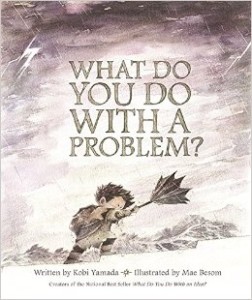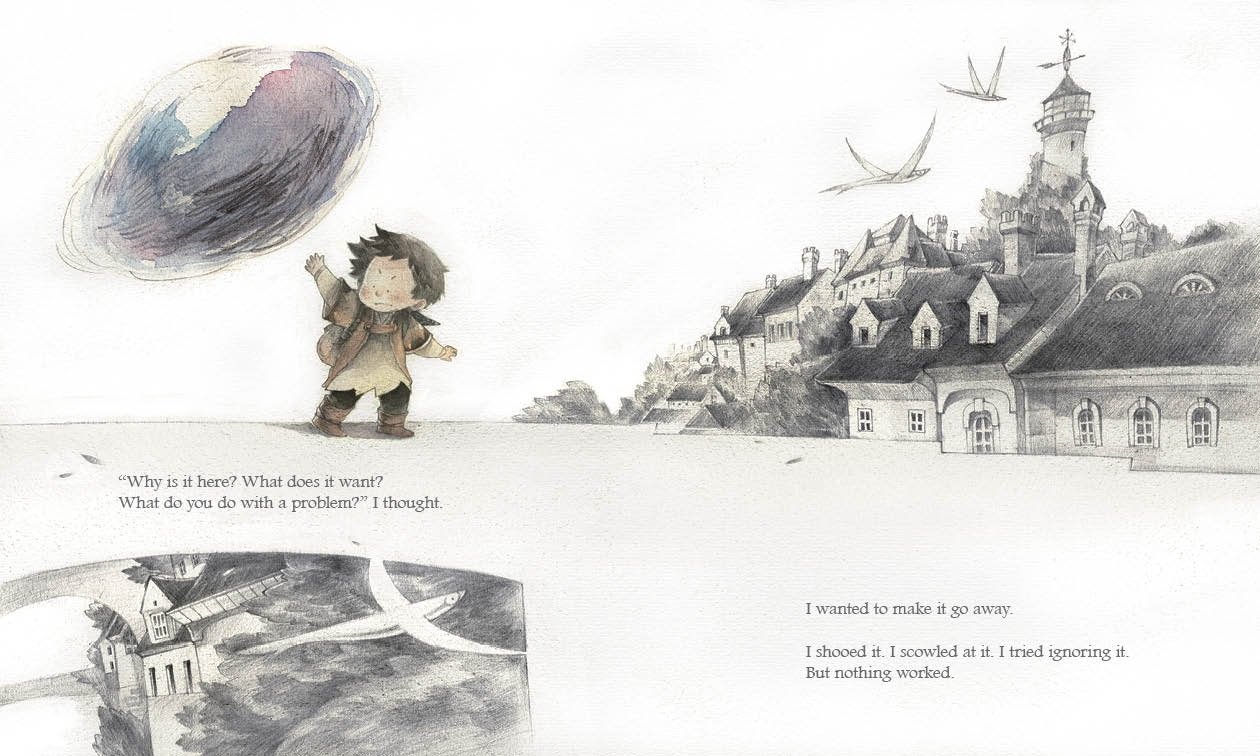What Do You Do with a Problem?
Author: Kobi Yamada; Illustrator: Mae Besom
Published: July 1, 2016 by Compendium Inc.
GoodReads Summary: From the same author and illustrator as our #1 nationally best-selling What Do You Do With an Idea? comes a new book to encourage you to look closely at problems and discover the possibilities they can hold.
What do you do with a problem? Especially one that follows you around and doesn’t seem to be going away? Do you worry about it? Ignore it? Do you run and hide from it?
This is the story of a persistent problem and the child who isn’t so sure what to make of it. The longer the problem is avoided, the bigger it seems to get. But when the child finally musters up the courage to face it, the problem turns out to be something quite different than it appeared.
This is a story for anyone, at any age, who has ever had a problem that they wished would go away. It’s a story to inspire you to look closely at that problem and to find out why it’s here. Because you might discover something amazing about your problem… and yourself.
What are problems for? They challenge us, shape us, push us, and help us to discover just how strong and brave and capable we really are. Even though we don’t always want them, problems have a way of bringing unexpected gifts.
So, what will you do with your problem? Now that’s up to you.
Review: There is something so magical about the combination of writer Kobi Yamada and illustrator Mae Besom. When I saw that these creators of What Do You Do with an Idea? had another book, I jumped at the chance to read it. It’s no secret that I am in love with this first book. I have gifted it to many friends and children, and I include it on many of my favorites and Top Ten Tuesday lists. I was pleased that What Do You Do with a Problem? is just as stunning. These two books are a teacher’s dream. They utilize many literary elements and are perfect for close analysis. I would use them at all grade levels. What Do You Do with a Problem? is a great text to teach readers how to reconsider a problem (or problems) that they might have. They can compare the problem with illustrations and consider how that problem may, for example, be all-encompassing. I like how the book balances both the weight of the problem and the proverbial light at the end of the tunnel. By looking at this problem in a new light, readers will be able to take more of an outside perspective of the conflict—and hopefully/potentially work toward a resolution.
Teacher’s Tools for Navigation: To start, teachers might ask students to consider the symbolism within the text. They might even grapple with the definition of an allegory and discuss ways the definition might be connected with the text and illustrations. Then, students could think of an abstract idea and try to associate an object with that idea. They might even consider writing their own picture book that connects the object and abstract idea. I also think it would be great for teachers to read both this text and What Do You Do with an Idea? to students. Then, they might compare and contrast the stories and their messages.
Discussion Questions: What do you do with a problem? How do we deal with problems in different ways? How do others in our lives deal with problems in ways that differ from us?; How do the author and illustrator work together to create a compelling story? What symbols do they use to convey their message?
Flagged Passage:
Image from: www.amazon.com
Read This If You Loved: What Do You Do with an Idea? by Kobi Yamada; The Most Magnificent Thing by Ashley Spires; The Dot by Peter H. Reynolds, The Noisy Paint Box by Barb Rosenstock, Lost and Found by Oliver Jeffers, Journey by Aaron Becker
Recommended For:






Excellent story to use with children and adults alike. I am a literacy Coach and plan to use this with our teachers to demonstrate the many ways this book can be used as an Interactive Read Aloud through turn & talk,pair share, and drawing what a problem you’ve had would look like and share with your neighbor.
Thank you for writing such a beautiful story.
Tania Toomer
Excellent story to use with children and adults alike. I am a Literacy Coach and plan to use this with our teachers to demonstrate the many ways this book can be used as an Interactive Read Aloud through: turn & talk, pair share, and drawing what a problem you’ve had would look like and share with your neighbor.
Thank you for writing such a beautiful story.
Tania Toomer
It is not my first time to pay a quick visit this web page, i am browsing this web site dailly and take pleasant data from
here everyday.
Good post. I learn something totally new and challenging on blogs I stumbleupon everyday.
It’s always interesting to read through articles from other authors and practice a little something from other sites.
I absolutely love this book and would love to post a video of me reading it on our school page during the Co-Vid 19 school closing. Is this allowed?
Hi! We are just a couple of teachers who review the books, so we can’t give these kinds of permission. I know that some authors have allowed readings as long as they are closed to the public’s view. You would have to ask the publisher if this book is being allowed as a read-aloud! If you can’t gain permission, we have a post that features authors reading aloud their books: http://www.unleashingreaders.com/?p=20534
SOOOOOO HELPFUL, IN GRAD SCHOOL FOR K-5 LEARNING AND THIS IS AMAZING
I am really thankful to the owner of this site who has shared this enormous article at at this time.